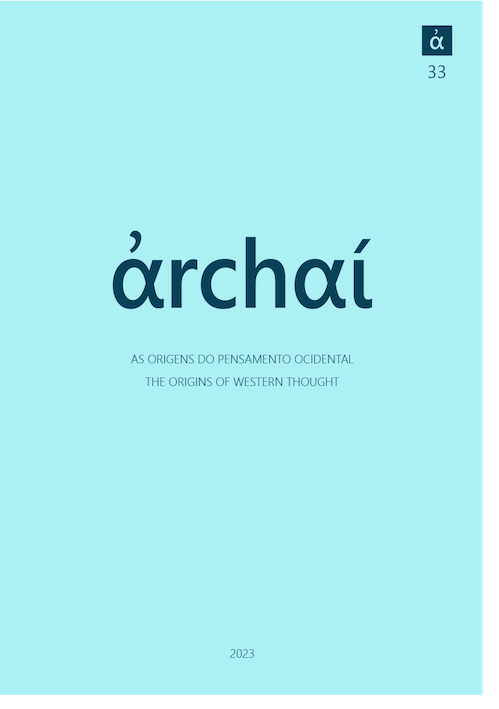Non casas, sed etiam domos fundatas: the origins of architecture from Vitruvius
DOI:
https://doi.org/10.14195/1984-249X_33_26Keywords:
Vitruvius, Architecture, ImitationAbstract
This work discusses the origin of the architect and the architecture presented in the treatise De Architectura by Vitruvius and its association with imitation. It is discussed the Vitruvian notion of the progression of humanity and its connections with the architect and the establishment of Architecture as the science of the architect. The proposal of training for professionals from various areas is analyzed, which would guarantee, according to Vitruvius, a generalist training and at the same time specialized in their field. It also discusses the attributes necessary, according to the author, for a good professional, which would allow him to achieve recognition for his authority.
Downloads
References
CALLEBAT, L. (1994). Rhétorique et Architecture dans le “De Architectura” de Vitruve. In: Le projet de Vitruve. Objet, destinataires et réception du De architectura. Actes du colloque international organisé par l'École française de Rome, l'Institut de recherche sur l'architecture antique du CNRS et la Scuola normale de Pise (Rome, 26-27 mars 1993), Rome, 1994, p. 31-46
CALLEBAT, L. (2004). Vitruve. De L’Architecture: Livre VI, Texte établi, traduit et commenté par Louis Callebat. Paris, Les Belles Lettres.
CORSO, A. (1988). Libri XXXIV, XXXV, XXXVI, Introduzioni, note e glossario degli artisti. In CORSO, A.; MUGELLESI, R.; ROSATI, G. Gaio Plinio Secondo. Storia Naturale, vol. V. Torino, Giulio Einaudi Editore.
CORSO, A.; ROMANO, E. (1997). Vitruvio. De Architectura A cura di Pierre Gros, traduzione e commento di Antonio Corso e Elisa Romano. Torino, Giulio Einaudi Editore .
ERNOUT, A. (1924). Lucrèce. De la Nature Paris, Les Belles Lettres.
FLEURY, P. (2003). Vitruve. De L’Architecture: Livre I, Texte établi, traduit et commenté par Philippe Fleury. Paris, Les Belles Lettres.
GROS, P. (1982). Vitruve: l’architecture et sa théorie, à la lumière des études récentes: Aufstieg und Niedergang der römischen Welt, II, 36, 1, Berlin, New York, p. 659-695.
GROS, P. (2003). Vitruve. De L’Architecture: Livre II, Texte établi et traduit par Louis Callebat, introduit et commenté par Pierre Gros. Paris, Les Belles Lettres.
MANENTI, L. (2019). The operational concepts in the Vitruvian system of design. Revista Archai 26, e02605. https://doi.org/10.14195/1984-249X_26_5
MANENTI, L. (2020). Integridade e Harmonia: princípios de beleza em Vitrúvio e Alberti. In: Mário Henrique Simão D'Agostino; Francesco Furlan; Andrea Loewen; Ana PaulaG. Pedro . (Org.). Leon Battista Alberti: Humanismo e racionalidades modernas 1ed.São Paulo: Annablume, p. 141-170.
ROMANO, E. (1987). La capanna e il tempio: Vitruvio o dell'architettura. Palermo, Palumbo.
RYKWERT, J. (2003). A casa de Adão no paraíso: a idéia da cabana primitiva na história da Arquitetura. São Paulo, Perspectiva.
SANTOS, S. G. C. dos. (2020). Vitruvian architecture and ancient rhetoric. Revista Archai , (28), e02804. https://doi.org/10.14195/1984-249X_28_4
VERNANT, J. (2018). As origens do pensamento grego Rio de Janeiro, Difel.
Downloads
Published
How to Cite
Issue
Section
License
Copyright (c) 2023 Leandro Manenti

This work is licensed under a Creative Commons Attribution 4.0 International License.
Given the public access policy of the journal, the use of the published texts is free, with the obligation of recognizing the original authorship and the first publication in this journal. The authors of the published contributions are entirely and exclusively responsible for their contents.
1. The authors authorize the publication of the article in this journal.
2. The authors guarantee that the contribution is original, and take full responsibility for its content in case of impugnation by third parties.
3. The authors guarantee that the contribution is not under evaluation in another journal.
4. The authors keep the copyright and convey to the journal the right of first publication, the work being licensed under a Creative Commons Attribution License-BY.
5. The authors are allowed and stimulated to publicize and distribute their work on-line after the publication in the journal.
6. The authors of the approved works authorize the journal to distribute their content, after publication, for reproduction in content indexes, virtual libraries and similars.
7. The editors reserve the right to make adjustments to the text and to adequate the article to the editorial rules of the journal.



